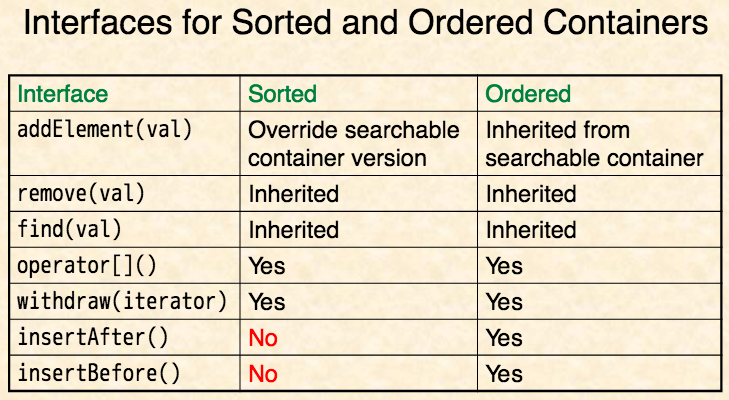Lecture 10 - Ordered, Sorted, Binary Search, and Sets

Linked List only preferred over an array when doing a lot of insertAfter(specific) and insertBefore(specific), or remove(iter)?
Binary Search in Sorted Container
int search(double a[], double val, int left, int right) {
while(right >= left) { // loop at most k times, k = log(n), O(log n)
int mid = left + (right - left) / 2;
if (val == a[mid]) return mid; // found elt
if (val < a[mid]) right = mid - 1; // check < first
else
left = mid + 1;
} // n is split in half each loop
return - 1; // didn't find elt
}
Better Binary Search in Sorted Container
int search(double a[], double val, int left, int right) {
int mid = left;
while(right >= left) {
mid = left + (right - left) / 2;
if (val > a[mid]) left = mid + 1; // check > first
else
right = mid - 1; // if val < a[mid]
}
return mid;
}
STL Binary Search
BINARY SEARCH
binary_search() returns a bool
FIND LOCATIONS in terms of ITERATORS?
Other methods of BINARY SEARCH
lower_bound()
upper_bound()
equal_range()
Comparators (Functors)
- Given elts a and b, tell if a < b
Searchable Containers as Sets
STL Set Operations:
- Union OR
- Intersection AND
- Set-difference AND-NOT
- Symmetric Difference XOR (o-plus symbol or o-minus symbol)
- Set of all objects that are in either A or B, but not both
- Cartesian Product (A x B)
- Set whose members are all possible ordered pairs (a, b), where a is a member of A, b is a member of B
- (1, 2), (1, 4), (2, 2) ,...
- All possible pairs (two elts): A x B = size(A) x size(B)
- Set whose members are all possible ordered pairs (a, b), where a is a member of A, b is a member of B
- Power Set (P(A))
- Set whose members are all possible subsets of A
- 2^size(A) subsets
- isElement exists
- isEmpty
- addElement
Set_Union()
template<class InIterator1, class InIterator2, class OutIterator, class Pred> // 4 classes
OutIterator set_union(InIterator1 first1, InIterator1 last1, InIterator2 first2, // 4 input iterators
InIterator2 last2, OutIterator result, Pred pred) { // 1 out Iter, 1 predicate
while(first1 != last1 && first2 != last2) {
if(pred(*first1, *first2))
*result++ = *first1++; // set1 elt < set2 elt, so output set1's elt, increment set1
else if (pred(*first2, *first1))
*result++ = *first2++; // set2 elt < set1 elt, so output set2's elt, increment set2
else {
*result++ = *first1++; // set1 elt == set2 elt, so output an elt from either set1 or 2,
// (in this case we chose set1) and iterate both sets
++first2;
}
}
while (first1 != last1) *result++ = *first1++; // remaining elts, if one set is larger than other
while (first2 != last2) *result++ = *first2++;
return result; // sorted union of 2 sets
}
Union-Find Data Structure
Idea 1: every disjoint set should have its unique representative (selected elt)
Idea 2: Compare representatives to tell if k and m are in the same set O(n) for updates
Idea 3: When performing union of 2 sets, update the smaller set
Idea 4: Don't store representative for each elt
Idea 5: Path compression, update the final representative for each elt in chain (later, in project 4)